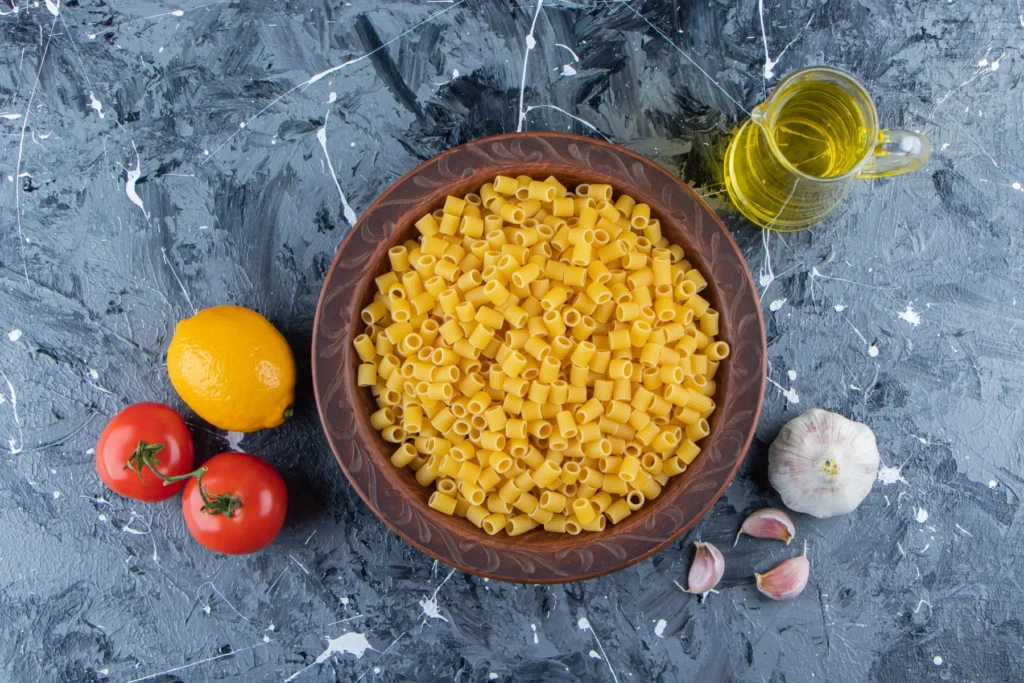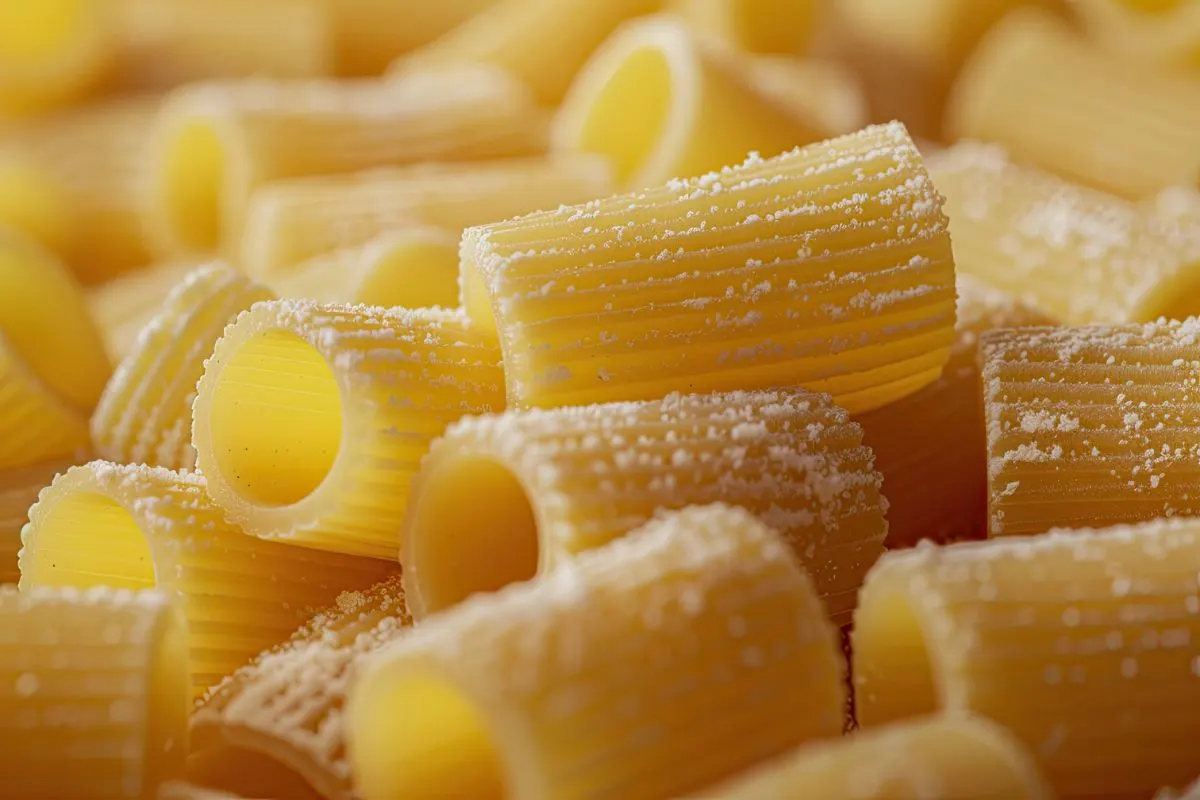Discover the subtle differences between ditali and ditalini pasta, their uses in recipes, and how each shape enhances your culinary creations.
Introduction
When exploring the world of Italian pasta, many cooks focus on the familiar shapes—spaghetti, penne, or fusilli. However, there is a whole category of tiny tubular pasta varieties that play a vital role in both traditional and modern dishes. Among these, two similar-looking yet subtly distinct shapes—ditali and ditalini—often raise questions. After all, they appear almost identical, but the subtle differences in size, texture, and culinary use can significantly impact how your meals turn out.
In the United States, these pasta shapes have grown popular, not just in traditional Italian-American kitchens but also among home cooks looking to expand their culinary horizons. Although both shapes are small tubes, the differences between ditali and ditalini influence cooking times, ingredient pairings, and the overall feel of a dish. Therefore, understanding what sets them apart can help you select the perfect pasta for your soup, salad, or baked casserole.
This article takes a deep dive into the origins, characteristics, and ideal culinary uses of both ditali and ditalini. It explores their historical context, nutritional aspects, and best cooking methods. In addition, it includes a comforting recipe to showcase how these pasta shapes shine in everyday cooking. By the end, you will have a comprehensive understanding that will empower you to choose the right shape for your next meal.
Table of Contents
The Family of Small Pasta Shapes

Exploring the World of Tiny Tubes
Small pasta shapes, often referred to as “pastina,” are a cornerstone of Italian and Italian-American cuisine. They are adored for their ability to fit seamlessly into broth-based soups, creamy salads, and hearty casseroles. These petite shapes, which include orzo, acini di pepe, and stelline, offer more than just aesthetics. Rather, they serve a practical purpose: their compact size allows them to blend easily with other ingredients, ensuring a balanced bite every time.
Ditali and ditalini belong to this family of small, tube-like shapes that are often chosen to complement vegetables, legumes, and flavorful stocks. These tiny shapes soak up broths and sauces, delivering bursts of flavor in each spoonful. In addition, their subtle shape differences can transform the mouthfeel and texture of recipes, making them versatile options in any pantry.
Understanding Ditali Pasta
Appearance and Shape
Ditali, whose name loosely translates to “thimbles,” are small, short tubes. They are slightly larger than their cousin ditalini, featuring a more robust diameter and a noticeably thicker wall. This gives them a chewy bite. Ditali typically have straight-cut ends, forming a neat, uniform shape that can hold onto thick sauces and ingredients quite well.
Origins of Ditali
Ditali have roots in Southern Italy, where small pasta shapes have long been integral to rustic, comforting dishes. Generations of Italian home cooks relied on these versatile tubes, which easily adapted to a wide range of regional ingredients. Although the exact origin story is not always documented, the shape’s popularity spread thanks to its adaptability and heartiness.
Texture and Cooking Properties
Ditali tend to maintain a pleasantly chewy texture when cooked al dente. This firmness makes them perfect for soups and stews that require a pasta shape capable of holding its structure, even after simmering. For example, they pair beautifully with robust, chunky vegetables and legumes because they can withstand longer cooking times without turning mushy.
When introduced into a soup, ditali often add body and help make a meal more substantial. Because of their thickness, the cooking time might be slightly longer than more delicate shapes, but this also ensures that they retain a satisfying bite, balancing the softer textures in a dish.
Common Dishes and Pairings
In Italian cuisine, ditali frequently show up in hearty soups like minestrone or pasta e fagioli. In these dishes, ditali’s sturdy form stands up to beans, vegetables, and sometimes even denser protein options like chickpeas. Its tubular shape can cradle bits of diced tomato or small vegetable chunks, ensuring every spoonful is flavorful.
Beyond soups, ditali can also appear in baked casseroles and thick ragù-based recipes. Because of their slightly larger hole, they catch bits of sauce, ensuring that every bite is rich and savory. This quality makes ditali suitable for comforting family dinners, meal prep, and dishes that you want to stay satisfying even after reheating.
Culinary Perception
Many chefs and home cooks see ditali as a reliable staple. They are often associated with comfort food that feels both wholesome and filling. In Italian-American kitchens, ditali have carved out a place of honor as a go-to shape for hearty soups meant to warm up cold evenings. Their firm texture ensures that every spoonful delivers a mouthful of nourishment.
Understanding Ditalini Pasta
Appearance and Shape
Ditalini, meaning “little thimbles,” share a similar tubular shape with ditali, but are notably smaller and thinner. They have a delicate profile and a tinier diameter. This petite size translates to a lighter mouthfeel, making ditalini an excellent choice for dishes where pasta should not steal the show, but rather, support the other ingredients.
Origins of Ditalini
Ditalini’s smaller size and dainty shape have roots in simple Italian peasant cuisine, where smaller shapes were economical and integrated easily into basic broths. When Italian immigrants arrived in the United States, they brought this shape with them. Over time, ditalini began to feature in numerous Italian-American recipes, especially those that celebrate simplicity, like a chicken broth-based soup.
Texture and Cooking Properties
Ditalini, while still offering a slight chew, cook more quickly than their larger counterpart. Their petite form absorbs flavors efficiently, often taking on the essence of the surrounding broth or sauce. Because they are smaller, it is easy to evenly distribute them throughout a dish, ensuring each spoonful has a balanced proportion of pasta to other ingredients.
This delicate texture makes ditalini well-suited to lighter, broth-based soups where the pasta should not overpower the flavors. It also works in pasta salads, where a lighter shape helps create a refreshing dish rather than a heavy meal.
Common Dishes and Pairings
Ditalini are best known for their presence in simple soups and lighter dishes. For example, they often appear in broths with tiny vegetables and legumes, or in the classic pasta e ceci, where the subtle pasta shape perfectly complements creamy chickpeas. Ditalini are also excellent in cold pasta salads, where their petite form mixes easily with finely chopped vegetables, herbs, and light vinaigrettes.
Because they are so small, ditalini are perfect for children or for anyone who prefers pasta that does not dominate a dish. They offer a delicate texture and ensure that every bite harmonizes with the dish’s overall flavor profile.
Culinary Perception
In many kitchens, ditalini are seen as the quintessential “comfort pasta” shape. They conjure images of a simple bowl of broth on a chilly day. Many remember them from childhood recipes, where their small size and mild presence made them especially appealing to picky eaters. Ditalini continue to enjoy popularity in recipes that focus on subtle flavor combinations.
Differences in Shape, Size, and Texture
Although ditali and ditalini are strikingly similar, several key differences help guide their culinary uses.
Size and Thickness
Ditali are larger, thicker, and have a more substantial bite. In contrast, ditalini are smaller and more delicate. Therefore, if you want a heartier bite, choose ditali. If you prefer a lighter touch, ditalini may be the better choice.
Texture Variations
Because of their thicker walls, ditali maintain a firmer texture when cooked. Ditalini, on the other hand, become tender slightly faster and blend seamlessly into dishes that prioritize subtlety.
Visual Distinction
When placed side by side, ditali look like slightly wider tubes, while ditalini are notably narrower. This visual clue helps you select the right shape for your recipe.
Practical Considerations
The differences in size and texture affect cooking times and the types of sauces or broths each can handle. Ditali work well with hearty sauces, while ditalini shine in lighter soups or salads. Choosing the right shape ensures that your final dish has the texture and flavor balance you desire.
Historical and Regional Context
These pasta shapes trace back to Italian culinary traditions that have evolved over centuries. In Italy, small pasta shapes were especially common in regions where soups and broths were dietary staples. Ditali and ditalini emerged as versatile staples that could adapt to both humble family meals and more elaborate feasts.
When Italian immigrants brought these pasta shapes to the United States, they embraced their versatility. Over time, these tiny tubes spread across grocery shelves nationwide. Today, both ditali and ditalini serve as bridges between authentic Italian culinary heritage and the evolving palates of American home cooks.
Nutritional Considerations
While pasta is primarily composed of carbohydrates, it also provides some protein and micronutrients, making it a filling choice in balanced meals. Both ditali and ditalini share a similar nutritional profile, as they are often made from durum wheat semolina.
Whole Grain and Gluten-Free Options
Modern dietary preferences have led to the availability of whole-grain and gluten-free versions of both ditali and ditalini. Whole-grain options provide more fiber, while gluten-free alternatives cater to those with intolerances or specific dietary needs. These variants allow everyone to enjoy these shapes without compromising on personal health guidelines.
Portion Sizes
Because both shapes are small, it is easy to add just the right amount to your dish. For those keeping an eye on portion control, small pasta shapes help distribute pasta evenly without overwhelming the meal.
Cooking Tips, Recipes, and Pairings
Selecting the right pasta shape is only half the battle—cooking it well and pairing it with complementary ingredients ensures the best results.
Cooking Times
Ditali typically take slightly longer to cook due to their thicker walls, often requiring 9-11 minutes for an al dente texture. Ditalini, being smaller, may cook in about 7-9 minutes. Always check package directions and taste as you cook to achieve the perfect tenderness.
Broths and Soups
- Ditali in Hearty Soups: Try using ditali in robust minestrone, lentil soups, or creamy vegetable chowders. The sturdy tubes hold their shape, offering texture and substance.
- Ditalini in Light Broths: For delicate chicken or vegetable broths, choose ditalini. Their smaller size allows flavors to shine without making the dish too heavy.
Salads and Sides
- Ditali in Mixed Vegetable Salads: If you want a salad with chunky vegetables or beans, ditali’s size helps you achieve a balanced bite.
- Ditalini in Light Pasta Salads: For lighter, summer-style pasta salads, ditalini’s petite shape creates an airy, refreshing dish that pairs well with fresh herbs and citrusy vinaigrettes.
Baked Dishes
- Ditali for Casseroles: The sturdiness of ditali makes it a great choice for baked dishes. For example, try a hearty vegetable and tomato casserole topped with cheese.
- Ditalini for Creamy Bakes: Ditalini’s smaller size fits well into creamy baked dishes. They ensure even distribution of sauce and make portion control easy.
Sauce Pairings
Ditali’s larger tubes can hold thicker sauces with ease, making them ideal for heartier ragù or chunky tomato sauces. Ditalini, however, shine in thinner broth-like sauces where the flavor can cling to every tiny piece.
Cultural and Seasonal Considerations
In colder months, ditali’s sturdy texture suits warming stews and hearty soups. In the warmer months, ditalini’s light presence pairs beautifully with crisp vegetables and fresh garden produce. Therefore, choosing one shape over the other can depend on seasonal ingredients and recipe needs.
Detailed Recipe: Vegetable Soup with Ditali

To illustrate how these shapes shine in a comforting meal, below is a detailed recipe using ditali. This simple yet flavorful soup highlights how the pasta’s shape and texture contribute to the final dish. Feel free to substitute ditalini if you prefer a more delicate texture.
Ingredients (Serves 4-6)
- 200g ditali pasta
- 1 medium onion, finely chopped
- 2 medium carrots, sliced into thin rounds
- 2 celery stalks, sliced
- 1 medium zucchini, diced small
- 1 cup chopped green beans
- 1 cup diced tomatoes (canned, no salt added)
- 1.5 liters low-sodium vegetable broth
- 2 cloves garlic, minced
- 2 tablespoons extra-virgin olive oil
- 1 teaspoon dried oregano
- 1 teaspoon dried basil
- 1 teaspoon salt (adjust to taste)
- ½ teaspoon black pepper (adjust to taste)
- 2 cups fresh spinach leaves, roughly chopped
- Fresh parsley, chopped (for garnish)
Step-by-Step Instructions
- Prepare the base:
Heat the olive oil in a large soup pot over medium heat. Add the onion, carrots, and celery. Stir frequently for about 5 minutes, or until the onion turns translucent. - Add aromatics and vegetables:
Add the garlic, oregano, and basil. Stir for another minute until fragrant. Then, add the zucchini, green beans, and tomatoes. Continue to stir, allowing the flavors to blend for an additional 2 minutes. - Add the broth and simmer:
Pour in the vegetable broth. Bring the mixture to a gentle boil, then reduce the heat to low. Cover the pot and let the soup simmer for about 15-20 minutes, or until the vegetables are tender but not mushy. - Cook the pasta:
Meanwhile, in a separate pot, bring water to a boil. Add a pinch of salt and then stir in the ditali pasta. Cook for 9-11 minutes or until al dente. Drain the pasta and briefly rinse with warm water to stop the cooking process. - Combine pasta and greens:
Add the cooked ditali to the soup pot, then stir in the spinach leaves. Let the soup simmer for another 2-3 minutes, allowing the spinach to wilt and the flavors to meld. - Season and serve:
Taste and adjust seasoning with salt and pepper. Ladle the soup into bowls and garnish with fresh parsley. Serve hot and enjoy.
Check out our detailed Ditalini Pasta Recipe
Nutritional Information (per 100g)
| Nutrient | Amount |
|---|---|
| Calories | 80 kcal |
| Carbohydrates | 13 g |
| Protein | 3 g |
| Fat | 2 g |
| Fiber | 2 g |
| Sodium | 200 mg |
| Vitamin A | 15% DV |
| Vitamin C | 10% DV |
| Iron | 4% DV |
| Calcium | 3% DV |
(DV = Daily Value; approximate values)
Selecting and Storing Ditali and Ditalini
When shopping for these pasta shapes, you will likely find both at most U.S. supermarkets. Always check the packaging for quality indicators, such as a short ingredient list that typically includes only durum wheat semolina.
Storage Tips
Keep your pasta in a cool, dry place. Once opened, store it in an airtight container to maintain freshness. Most dried pasta shapes will remain fresh for up to 1-2 years, but it is best to use them within a reasonable timeframe to ensure optimal flavor.
Buying in Bulk or Specialty Markets
Ditali and ditalini are widely available. However, if you seek premium-quality pasta, consider visiting specialty Italian markets. High-quality pasta can improve texture and flavor in your finished dish, making it worthwhile if you love cooking with these shapes frequently.
Frequently Asked Questions (FAQs)
Is ditali pasta the same as ditalini pasta?
No, ditali and ditalini are not the same. Although they share a tubular shape and are both small, ditali are slightly larger and thicker. Ditalini are narrower and more delicate, which results in different cooking times, mouthfeel, and best uses in recipes.
What is the closest pasta to ditalini?
If you cannot find ditalini, you can use other small pasta shapes like acini di pepe, small elbows, or even small shells as a substitute. However, keep in mind that these alternatives may offer a slightly different texture and mouthfeel.
What does ditalini mean in English?
“Ditalini” translates to “little thimbles” in English. The name refers to the pasta’s small, cylindrical shape, reminiscent of tiny sewing thimbles.
What type of pasta is ditalini?
Ditalini is a small, short tube-shaped pasta commonly used in Italian and Italian-American soups, salads, and light pasta dishes. It is part of the pastina family, which includes many small shapes suited for broths and delicate sauces.
Are there whole-grain options for ditali and ditalini?
Yes, you can find whole-grain versions of both shapes, often made from whole-wheat semolina. These options provide more fiber and nutrients while still offering the comforting experience of eating pasta.
Conclusion
In the world of small tubular pasta, ditali and ditalini may look similar, but understanding their differences can significantly elevate your cooking. Ditali’s larger, sturdier shape stands up well in hearty soups and baked casseroles, while ditalini’s petite form is perfect for light broths, creamy salads, and delicate dishes.

